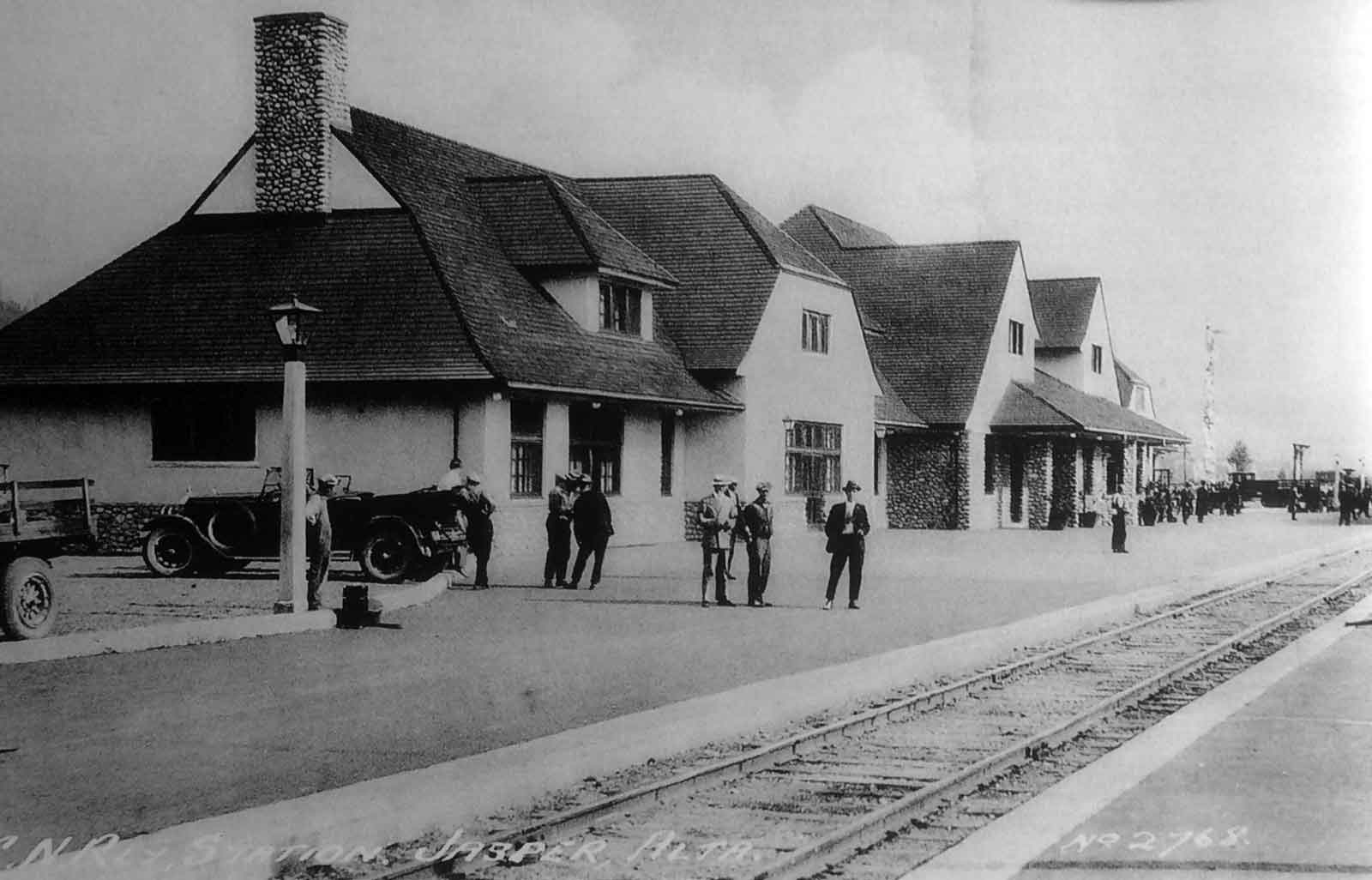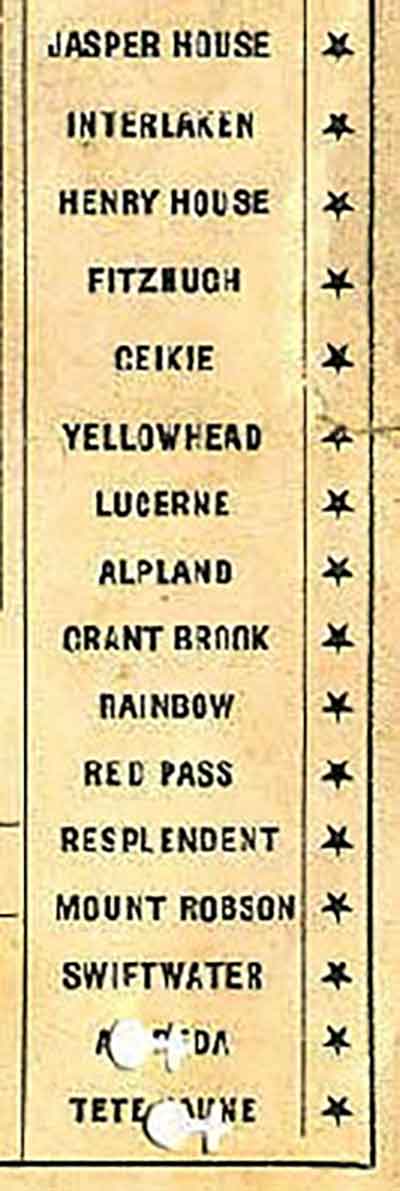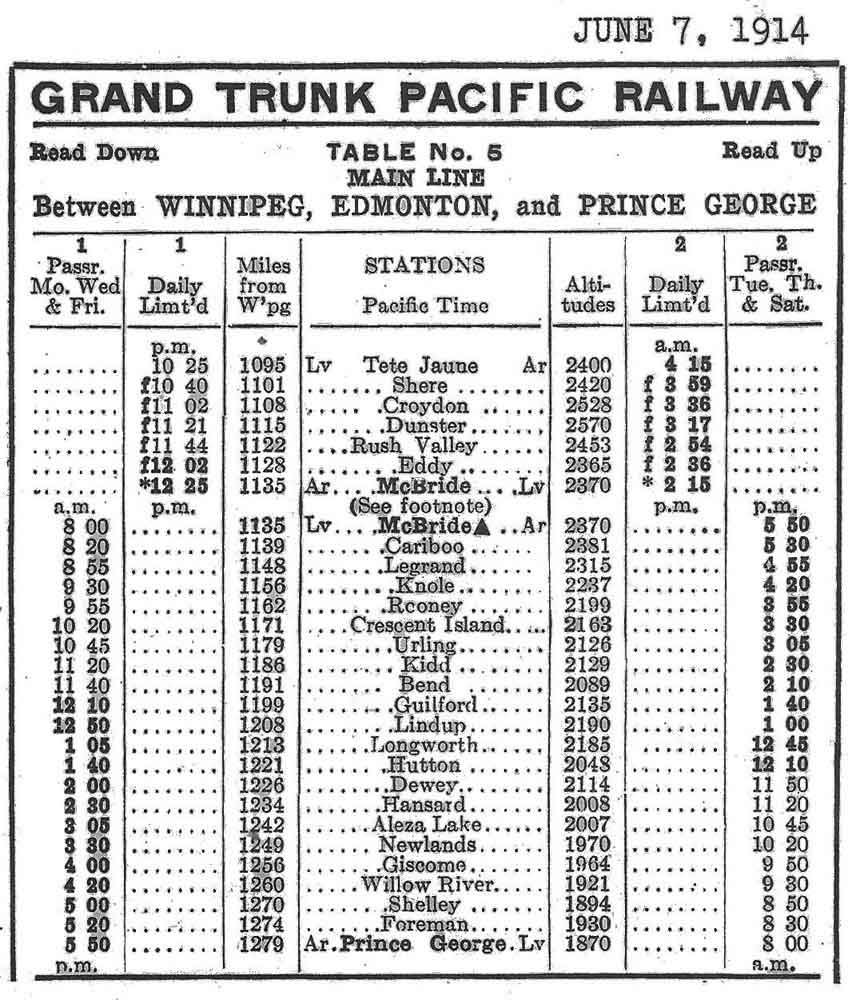Category Archives: Place
Canadian National Railway Subdivisions 1977

Mountain Region – Yellowhead Division
Albreda Subdivision
Jasper to Blue River – 132 miles
CNRHA
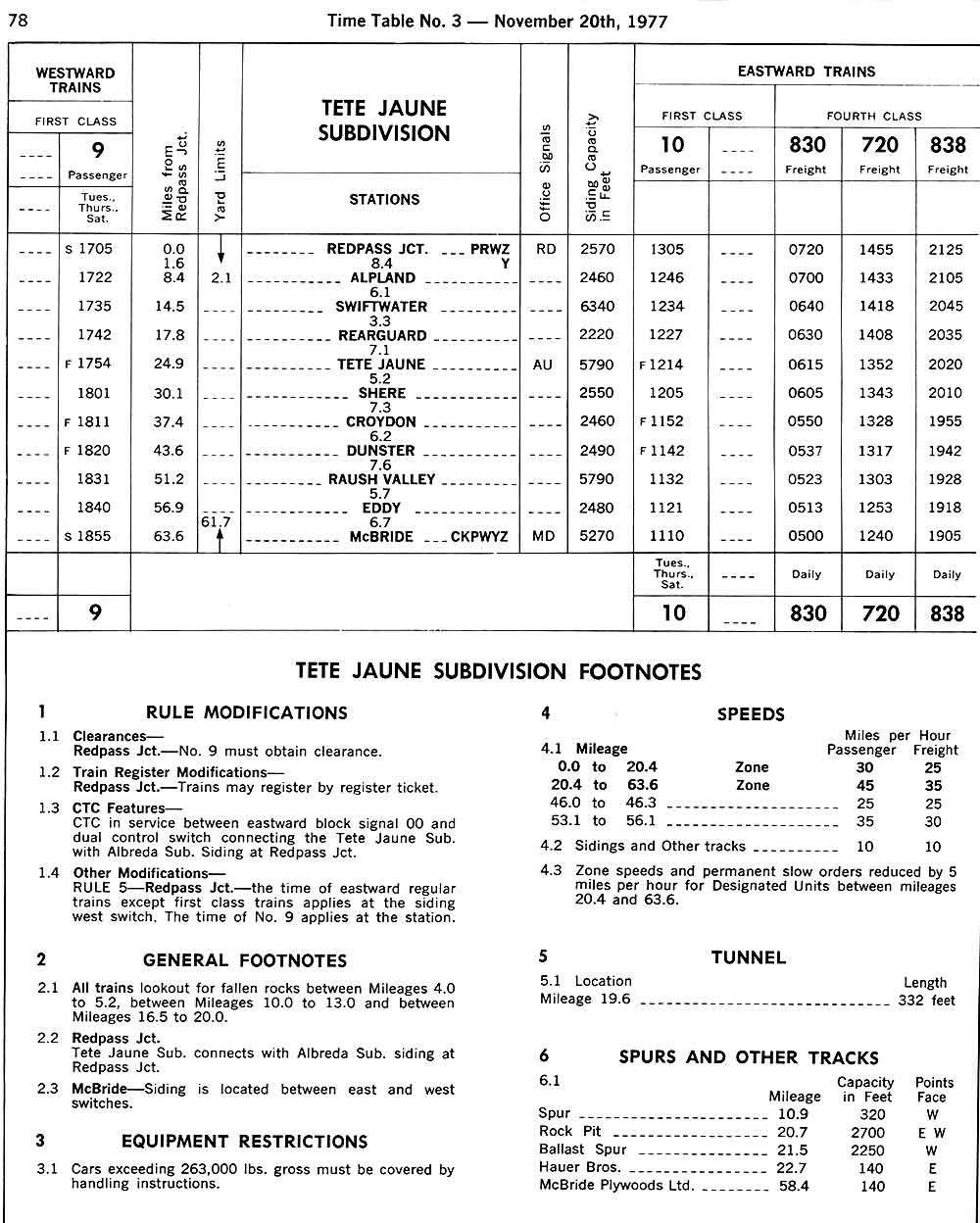
Mountain Region – BC North Division
Tete Jaune Subdivision
Redpass to McBride – 63.9 miles
CNRHA
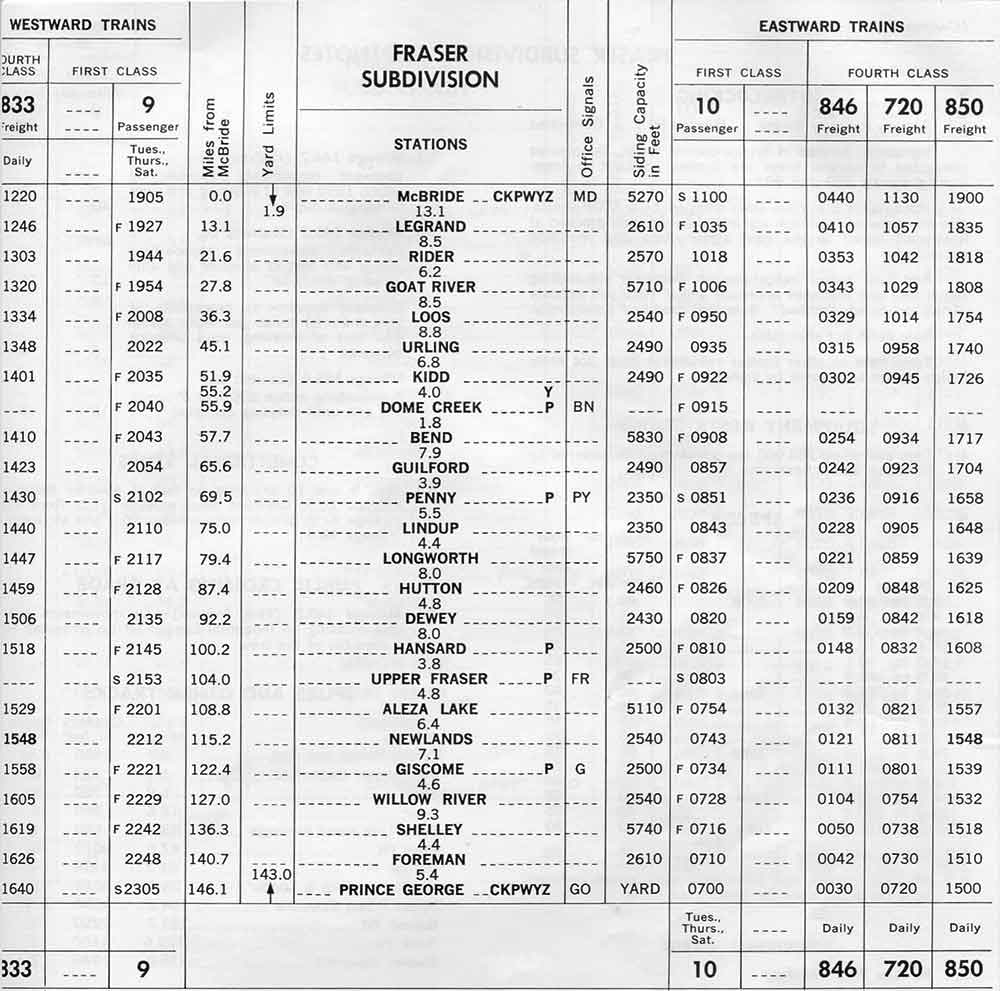
Mountain Region – BC North Division
Fraser Subdivision
McBride to Prince George – 146 Miles
CNRHA
- Canadian National Railways Historical Association. Timetables. Canadian National Railway, 1977. CNRHA
Prince George
Surrounding the confluence of Nechako River and Fraser River
53.9131 N 122.7453 W — Map 093G15 — Google — GeoHack
Earliest known reference to this name is 1914 (GTP Timetable)
Name officially adopted in 1915
Official in BC – Topo map from Canadian Geographical Names
Mile 146 in Fraser Subdivision (McBride to Prince George as of 1977)
Grand Trunk Pacific Railway station built in 1913. Rebuilt 1922, 1971
Grand Trunk Pacific Railway map [ca. 1912]
Grand Trunk Pacific Railway timetable 1914
Grand Trunk Pacific Railway map ca. 1918
Grand Trunk Pacific Railway stations
“Prince George” appears on the 1914 Grand Trunk Pacific timetable, at Mile 234 from the Yellowhead Pass. The city was incorporated on 6 March 1915. Originally Fort George, a trading post founded in 1807 by Simon Fraser of the North West Company and named after King George III of Great Britain.
- Bohi, Charles W., and Kozma, Leslie S. Canadian National’s Western Stations. Don Mills, Ontario: Fitzhenry & Whiteside, 2002
- British Columbia Geographical Names. Prince George
Crescent Spur Creek
Flows SW into Fraser River, E of Crescent Spur
53.5847 N 120.6781 W — Map 093H10 — Google — GeoHack
Earliest known reference to this name is 2016
Name officially adopted in 2016
Official in BC – Canada
Adopted in 2016 on as required for water licensing. The mouth is located at Crescent Spur so name seems fitting.
- British Columbia Geographical Names. Crescent Spur Creek
Jasper
On Athabasca River E of Yellowhead Pass
52.8778 N 118.0831 W — Map 083D16 — Google — GeoHack
Name officially adopted in 1951
Topo map from Canadian Geographical Names
Mile 0 in Albreda Subdivision (Jasper to Blue River as of 1977)
Grand Trunk Pacific Railway station built in 1912 when the site was known as Fitzhugh. Station rebuilt in 1924 by Canadian National Railway
Palliser Map 1863
Grand Trunk Pacific Railway map [ca. 1912]
Grand Trunk Pacific Railway map ca. 1918
Grand Trunk Pacific Railway map 1919
Canadian National Railway map 1925
Grand Trunk Pacific Railway stations
The town of Jasper is named after a
North West Company fur brigade post established in 1813 on Brûlé Lake. It was first mentioned in by Gabriel Franchère [1786–1863] in his Relation d’un voyage à la Côté du Nord-Ouest de l’Amérique Septentrionale (1820). The post was a “provision depot with the view of facilitating the passage of the mountains through Athabasca Pass.” Franchère called the post “Rocky Mountain House,” managed by François Décoigne, whom some have identified with Pierre Bostonais dit “Tête Jaune” [d. 1827].
In 1817, the position was filled by Jasper Hawse, whose name was adopted to distinguish the post from the new Rocky Mountain House established on the North Saskatchewan River. In 1821, the Hudson’s Bay Company and the North West Company amalgamated and by 1824, Michael Clyne was in charge of the post. In 1829, Clyne built a new post at the junction of the Athabasca River and the Snake Indian River. From 1835 to 1849, Colin Fraser [1805–1867] ran the post.
In the early 1850s, it was closed as it was losing money. It was then reopened by Henry John Moberly [1835–1831] and then closed in the late 1850s.
The Jasper Forest Reserve, later Jasper Forest Park, was named for the original fur brigade post. The confluence of the Miette and Athabasca rivers was selected by the Grand Trunk Pacific Railway as the location for their divisional point. This crew-changing station was given the name “Fitzhugh” in 1911, after a prominent Grand Trunk Pacific official. The following years, the name was changed to assume that of the new national park in which it was situated.
Bohi:
The Grand Trunk Pacific and Canadian Northern railways serviced many resorts in the West. Not surprisingly, the GTP utilized standard structures at these locations, for example at Nakina, Ontario; Watrous, Saskatchewan; Cooking Lake, Wabamun, and Jasper, Alberta. In contrast, many CNoR resorts had special depots. In 1910 R. B. Pratt designed a simple station for Westside, Manitoba, later renamed James. It was comprised of a single storey building canopies on each end. Inside was a large waiting room, a small office with a bay window, and a freight and baggage room. This became the prototype for at least four other depots, including the one built at Jasper in 1915, shown above. The Jasper station virtually repeated Westsides floor plan, but was finished to a higher standard, with a stone plinth and metal roofing. [p. 37]
The former Grand Trunk Pacific station at Jasper burned down late 1924. In keeping with its reputation as world-class tourist destination, Canadian National Railway Architect Schofield designed a replacement station that was a masterpiece. Its massing borrowed freely from English rural residential architecture and featured a plinth of local cobblestones capped with a course of Tyndall stone. The walls above were of brick, finished on the exterior with rough-cast stucco. The plaster and oak-beamed, vaulted ceiling in the general waiting room was naturally lighted by clerestory glazing. Other services included a restaurant and a dining room, with a feature fireplace and massive cobble chimney. Living accommodation for station staff was provided on the second level. The Jasper station was restored under the auspices of Parks Canada in 2001. [p. 42]
- Franchère, Gabriel [1786–1863], and Lamb, William Kaye [1904–1999], editor. Journal of a Voyage to the Northwest Coast of America, in the years 1811, 1812, 1813, and 1814. Toronto: Champlain Society, 1969. Internet Archive [accessed 10 March 2025]
- Bohi, Charles W. Canadian National’s Western Depots. The Country Stations in Western Canada. Railfare Enterprises, 1977
- Karamitsanis, Aphrodite [1961–]. Place names of Alberta. Volume 1: Mountains, Mountain Parks and Foothills. Calgary: University of Calgary Press, 1991. Internet Archive [accessed 25 February 2025]
Grand Trunk Pacific Railway ticket 1914
GRAND TRUNK PACIFIC RAILWAY
Train Ticket — Not Transferrable — Edmonton to Tete Jaune
Ticket 223531 Form D18
Punched: June 30 1914, Albreda to Tete Jaune, 30 cents
This Grand Trunk Pacific Railway ticket was discovered among the possessions of Wilfred D. Jowett, son of William A. Jowett, a magistrate at Tête Jaune Cache in the 1913 – 1915 era. From Community Stories, Valemount & Area Museum.
On this ticket “Jasper House” is not the current town of Jasper, but a location near the site of fur-trading post. The name “Fitzhugh” was changed to “Jasper” in 1913 when the GTP built its divisional point there.
Albreda (GTP railway point)
Alpland
Fitzhugh
Geikie
Grant Brook (GTP railway point)
Henry House
Interlaken
Jasper House
Lucerne (GTP railway point)
Mount Robson (railway point)
Rainbow (GTP railway point)
Red Pass (railway point)
Resplendent (GTP railway point)
Swiftwater
Tête Jaune station
Yellowhead (railway point)
Grand Trunk Pacific Railway timetable 1914
Grand Trunk Pacific Railway
Main Line Between Winnipeg, Edmonton, and Prince George.
Table 5 — Tete Jaune to Prince George
Showing passenger schedules, miles from Winnipeg, and altitudes.
Highway 5
Téte Jaune Cache to Hope
Roads are not in the official geographical names databases
Highway 5 is a 543 km (337 mi) north–south route in southern British Columbia, Canada. Highway 5 connects the southern Trans-Canada route (Highway 1) with the northern Trans-Canada/Yellowhead route (Highway 16), providing the shortest land connection between Vancouver and Edmonton. Despite the entire route being signed as part of the Yellowhead Highway, the portion of Highway 5 south of Kamloops is also known as the Coquihalla Highway while the northern portion is known as the Southern Yellowhead Highway.
- Wikipedia. British Columbia Highway 5
Highway 16
British Columbia section: Yellowhead Pass to Prince Rupert
Roads are not in the official geographical names databases
Highway 16 is a highway in British Columbia, Canada. It is an important section of the Yellowhead Highway, a part of the Trans-Canada Highway that runs across Western Canada. The highway closely follows the path of the northern B.C. alignment of the Canadian National Railway. The number “16” was first given to the highway in 1941, and originally, the route that the highway took was more to the north of today’s highway, and it was not as long as it is now.
- Wikipedia. British Columbia Highway 16
Yellowhead Highway
Winnipeg to Graham Island off the coast of British Columbia via Saskatoon and Edmonton
Roads are not in the official geographical names databases
The highway, named for the Yellowhead Pass, is a major interprovincial route in Western Canada that runs from Winnipeg to Graham Island off the coast of British Columbia via Saskatoon and Edmonton. It stretches across the four western Canadian provinces of British Columbia, Alberta, Saskatchewan, and Manitoba.
The Yellowhead Highway is part of the Trans-Canada Highway system and the larger National Highway System, but should not be confused with the more southerly, originally-designated Trans-Canada Highway. The highway was officially opened in 1970. Beginning in 1990, the green and white Trans-Canada logo was used to designate the roadway.
The main Yellowhead Highway has been designated as Highway 16 for its entire length since 1977. Prior to this, only the Alberta and British Columbia portions of the highway were designated with this number.
A spur of the Yellowhead Highway, Highway 5, also known as the Southern Yellowhead Highway, connects the main highway at Tête Jaune Cache midway between the Alberta-British Columbia border and Prince George. The highway continues past Kamloops before following the Coquihalla Highway to Hope. Unlike Highway 16, route 5 is not branded as being part of the Trans-Canada system and retains the original Yellowhead signage (whereas Highway 16 uses the Trans-Canada Highway logo).
- Wikipedia. Yellowhead Highway


